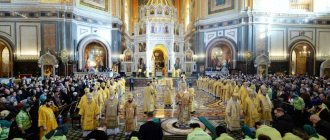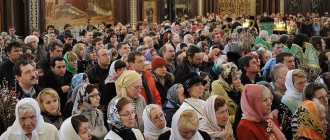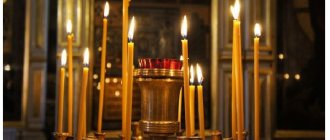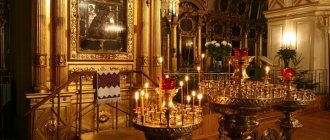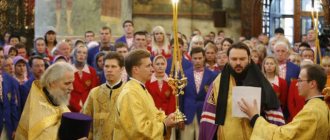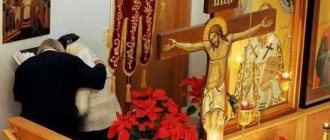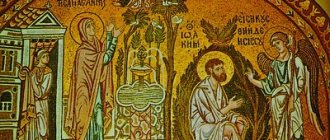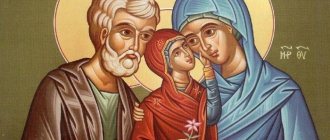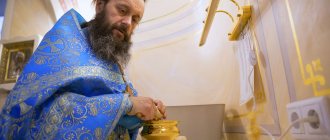According to the pious tradition that has developed in Rus', when entering the monastery, women cover their heads, men take off their headdress. Closed, modest clothing is also accepted - a dress or skirt for women, trousers for men. When entering the monastery, you must make the sign of the cross three times and bow to the shrine. Despite the warm weather, all parishioners are encouraged to wear long sleeves. Sometimes it is allowed for a woman to enter the monastery in trousers if her decision to enter the church was not planned in advance, but she must use the clothing (scarf and skirt) provided at the entrance to the temple.
Why do Orthodox Christians venerate the relics of God's saints?
The tradition of venerating the relics of holy saints is based on the miracle of the Incarnation. The Christian Church believes that Jesus Christ was resurrected not only spiritually, but also physically, therefore the physical shell of a person has no less value than the soul. People who achieved unity with the Lord during their lifetime became the receptacle of His Grace, which they poured out into the world around them. This ability is possessed not only by a living body, but also by the remains of a holy person.
Holy relics are the greatest shrines of the Orthodox Church
The veneration of holy relics was officially established at the Second Ecumenical Council. At the same time, the priests emphasized the importance of understanding the fact that worship is performed neither to the remains nor to the person, but to the Divine Power contained in them.
Candles for health
Candles for health
placed in special candlesticks, which are located under the images. Repose candles are placed on a special canon, which is easily recognized by its square shape and the presence of a small crucifix. You can light a candle with either hand. It is very good to place the first candle in front of the main shrine of the temple. The candles are lit one from the other, which is burning, and, having melted the bottom, they are placed in the socket of the candlestick. The candle must stand strictly straight. If on the day of a great holiday a minister extinguishes a candle in order to light the candle of another, do not be disturbed in spirit: the sacrifice has already been accepted by the All-Seeing and All-Knowing Lord. In an Orthodox church it is customary to stand during services. You can only sit while reading kathismas (Psalms) and proverbs (readings from the Old and New Testaments at Great Vespers on great holidays and days of remembrance of especially revered saints). The rest of the time, you are allowed to sit down and rest in cases of ill health. Saint Philaret of Moscow said well about bodily weakness: “It is better to think about God while sitting than to think about your feet while standing.”
The meaning of the application to holy relics
A person who goes to venerate holy relics must understand that he is not worshiping the remains of a holy person, but God’s Grace. As during prayer in front of the icon, so during application to the relics of the holy primates, a person turns to their spirit, which is located at the Heavenly Throne. Holy people who have known His Grace during their lifetime are conductors of human prayers and the Will of the Lord.
Similar articles:
- Veneration of saints in Orthodoxy
- What are the relics of saints and why are they revered
Before the holy relics, people pray for the following:
- about the granting of physical and mental health;
- about strengthening the spirit and faith;
- about gaining strength to overcome the trials and difficulties of life;
- about help in family conflicts.
Worship of honorable holy remains can be performed not only for the purpose of asking for help and intercession, but also to express respect for a person who has accomplished a spiritual feat and received the special mercy of the Savior.
Pastors on the veneration of holy relics
The relics of Saint and Wonderworker Nicholas, Archbishop of Myra in Lycia, brought from the Italian city of Bari, now reside in Russia. Now they are in St. Petersburg. Already 2 million people have come to bow to them, including to ask for something of their own, something painful. But what exactly, from an Orthodox point of view, should one ask from a saint? What benefits? Can we be talking about worldly blessings and purely earthly things here? What should you pay attention to so that the worship of the saint does not have a pagan character?
At the relics of St. Nicholas
Pray for what you consider useful in your earthly life, but entrust the fulfillment of this into the hands of God
Priest Valery Dukhanin:
– My wife prayed for a duck when she was a child. The dog gnawed at her neck, the duck seemed hopeless, and so my wife, at that time still a very small child, prayed with tears to the holy healer Panteleimon for the duck, and the duck recovered. Some will say that this is not serious. But I personally think that if a child prays from the heart for a living being, then as an adult he will have compassion.
It is clear that people go to shrines and often pray only for earthly things. I think we need to approach this more simply. Thank God that people are already praying, standing in long lines at shrines, and not going somewhere unknown. Everyone prays to the extent of their physical and spiritual age, to the extent of their understanding of what is most valuable. And God condescends to us and sometimes fulfills our most absurd requests.
I remember this patristic rule pronounced by Saint Ignatius (Brianchaninov): pray for what you consider useful in your earthly life, but entrust the fulfillment of this into the hands of God . If you think that you need something, you can ask for it, but whether it should be or not, let God decide. Place yourself in His hands.
Priest Valery Dukhanin
You cannot immediately jump to spiritual perfection, so that everything earthly immediately ceases to interest you. By demanding dispassion from yourself in relation to simple human life, instead of spiritual perfection, you can slide into indifference, apathy and indifference. People worry about their health, the well-being of loved ones, and pray that their children’s problems will be resolved. They pray to pass the exam and not to be fired from work, they pray for friends. And this confirms that the heart is still alive, and most importantly, people turn to God, they seek help from Him.
In prayer, we must definitely exclude evil requests. To take revenge on the offender, to punish your neighbors, to teach someone you hated a lesson - all this definitely cannot be asked for in prayer. God is Love, Good, Life, and therefore what is contrary to love, good and life cannot be asked in prayer. This way you will move away from God and bring trouble upon yourself.
We need to pray not for the cross to be removed from us, but for us to be given the strength to bear the cross
There was a case in my life a long time ago when I found it unbearable to work with the boss I had. I prayed for the dismissal of my boss, I prayed from my heart, and after a few days my request was fulfilled. I was incredibly happy, but the new boss, who seemed kind and not so demanding, turned out to be much more difficult. And in the end it only became harder for him. The Lord then returned the former boss, and it was clearly shown to me that it was impossible to ask for relief from earthly affairs. God Himself knows how to manage our lives. Therefore, we need to pray not for the removal of the cross from us, but for the granting of strength to us to bear the cross.
In our prayers, we will try to remember that the most important value a person has is his immortal soul. First of all, we must pray for the salvation of the soul, to cut off the sins and passions that hinder us. One girl I know suffered from a strong drug addiction for a long time and could not break free. But she found the strength to ask the Lord to somehow help her. She asked for a year or two, and nothing seemed to work out. And so her mother went to the Holy Land and at the Holy Sepulcher she also prayed for her daughter with all her heart. Literally the next day, the girl woke up in the morning and suddenly felt that her craving for drugs had disappeared. She didn't even understand why this happened. She went out into the street, somewhere she saw other drug addicts and again noticed that she had no craving for it, she didn’t even experience withdrawal. This is how prayer from the bottom of your heart, especially when you are not praying alone and someone is praying for you at a shrine, performs a real miracle.
The first thing you need to ask for is success in spiritual life
Priest Dimitry Shishkin
Priest Dimitry Shishkin:
Along the unsearchable paths of God, we sometimes need to experience sorrows, illnesses, and failures
– In fact, an Orthodox Christian should not even ask such a question: what should he ask of a saint? First of all, anyway. About increasing faith and love for God and neighbors, about determination in fulfilling the commandments of Christ, about knowledge of His holy will and about the gift of understanding and strength for its fulfillment. In a word, the first thing we need to ask for, regardless of the circumstances of life, is for success in spiritual life both for ourselves and for our loved ones, because this is the main thing in the perspective of our eternity. Of course, there are some emergency circumstances, needs, illnesses, disasters in our lives and the lives of our loved ones, when it is simply impossible not to ask for help in specific, everyday needs. When a person literally, as they say, cries out. Is it possible? It is possible and necessary, of course, but at the same time we must have humility, a certain space of the heart, realizing that some things are the will of God and others are the will of man, and in the unsearchable ways of God we sometimes need to experience sorrows, illnesses, failures, and vice versa - what we ask for is not always useful for us, no matter how obvious and blatantly necessary what we ask may seem to us. It is in this simple thing: “but not as I want, but as God pleases” that humility, which is necessary to be applied to every deed and to every prayer, consists.
God is the Source and the Sun, and the saints are mirrors reflecting His light
Priest Svyatoslav Shevchenko
Priest Svyatoslav Shevchenko:
Pray as if your life depended on this prayer
– I honestly admit that I don’t quite understand the hype around this event. It is clear that St. Nicholas the Wonderworker is a very revered saint in Russia, but there is a feeling that a considerable part of people do not go to God, but for a miracle. This shouldn't happen. Because in Orthodox Christianity, God alone is the Giver of all blessings. He is the Source, and His saints are just wires. He is the Sun, and His saints are only mirrors reflecting His light. And if a person approaches a shrine with relics and makes a wish or believes that kissing it will solve all his problems, this is paganism and idolatry.
Everything about the nature of prayer was said before me by the holy fathers who were practicing Christians. If we describe this practice briefly, we get three points. Firstly, a person must approach prayer with humility: awareness of his spiritual damage and imperfection. Secondly, to understand that God and the saints see right through you in real time is a unique experience of standing before the Lord. Thirdly, pray as if your whole life depended on this prayer.
Patriarch of Moscow and All Rus' Kirill on pilgrimage and veneration of the holy relics of Nicholas the Wonderworker, Archbishop of Myra in Lycia:
Patriarch of Moscow and All Rus' Kirill. Photo: patriarchia.ru
– Saint and wonderworker Nicholas, as revered as St. Sergius among our people, during almost two months of his stay in the Russian Land, gathered two million people with his relics. And this was a genuine pilgrimage associated with feat, with overcoming difficulties. People stood and stand for hours to venerate the relics. I was told how elderly and unhealthy people were asked to go forward without a queue, but they refused, saying: “It’s important for me not only to venerate the relics - it’s important for me to stand, it’s important for me to pray”...
We bring repentance, prayer and, of course, requests to the holy relics
What motivates people? Nothing material. From this they receive neither comfort, nor monetary reward, nor honor, nor respect, and many also slander honest pilgrims. But believers do not seek praise from people, nor do they seek immediate visible well-being. They turn to the saints with their most secret things, they entrust their souls, they pray for themselves, for their family and friends - and they know that before the holy relics, where Divine grace is especially powerful, their prayers are fulfilled.
Some are perplexed and ask us: how do you, living in the 21st century in a European country, maintain such faith? What does this all mean? I met with some Western sociologists who interrogated me passionately about what was behind all this, believing that this, like mass political actions, has a simple human explanation: someone benefits from changing power, someone wants it to protect, someone is fighting for their economic rights, someone believes that they should be in power, and by uniting with like-minded people, people really come out in large numbers. But all this is so far from what happens during the pilgrimage! We pray to the holy saints not in order to gain power, and not so that we have more money. We pray about the most important thing - about our inner, spiritual, secret, for each of us. We bring repentance, prayer and, of course, requests to the holy relics - for ourselves, for our family and friends, for our Fatherland, for our Church. And we know for sure that the saints, gifted by God, answer our prayers.
(Word by His Holiness Patriarch Kirill on the day of memory of St. Sergius of Radonezh in the Trinity-Sergius Lavra, July 18)
Holy relics and church etiquette
The presence of holy relics in any locality is an important event in the spiritual life of this region. A long line of Christians line up at the shrine, wanting to partake of Divine grace. Large crowds of people require that every believer observe church etiquette and special recommendations of the Orthodox Church for pilgrims.
Holy relics help Christians strengthen their faith and experience God’s grace
When visiting any Orthodox religious organization, the following rules should be observed:
- The pilgrim's clothing must comply with pious Christian traditions. Women should wear long-hemmed clothing that covers their shoulders. The presence of a headdress for ladies is a mandatory requirement. Men should choose items that cover their knees and shoulders.
- You cannot approach the shrine while under the influence of alcohol or drugs.
- While in church, you should maintain silence, do not jostle or argue with other parishioners.
Many people come to venerate the relics. The clergy consider standing in line at the shrine a spiritual test for the pilgrim. This time can be spent doing the following:
- reading the life and akathist to the saint;
- a prayer appeal to the primate, which sets out a request;
- writing notes for a prayer service read by priests at the relics.
When planning to venerate the relics, you should take into account weather conditions and your own state of health. If necessary, you should take the following items with you:
- an umbrella that protects from both the sun and precipitation;
- folding chair;
- medicines;
- water in a plastic container.
Pilgrims who take children for attachment should take into account that they cannot concentrate on monotonous activities for a long time. Parents should consider what to do with their children while they wait. The child should be prepared for visiting the temple and applying to the relics as follows:
- talk about the life of the holy man whose relics they decided to venerate;
- explain the meaning of the action taking place;
- talk about the structure of the temple, the role of priests in the spiritual life of a person.
Icon with a particle of the relics of St. Luke of Crimea, wonderworker
During your stay in the temple, you should answer the child’s questions in a quiet voice. A pilgrimage to the shrine should leave good and bright feelings in his soul.
Enter the temple
Enter the temple
you need to calmly, silently, with reverence. In this case, the man must remove his headdress, and the woman, on the contrary, must put a scarf on her pre-collected hair. When you enter the temple, make three bows to the ground (on holidays - three bows from the waist), then bow to the worshipers to the right and left. Such rules are sometimes difficult to observe in a church full of parishioners, so you are allowed to walk a little to the side and cross yourself three times, while making three bows from the waist. It is also necessary to make the sign of the cross upon entering the temple.
How to properly venerate the relics of saints
Believers should understand that many pilgrims want to touch the holy relics. In order not to prolong the wait for them, while at the shrine, you should adhere to the following sequence of actions:
- When approaching the shrine with the shrine, you should bow to the ground twice.
- After bowing you should cross yourself.
- After making the sign of the cross, the pilgrim venerates the relics. You should touch the exposed limbs or clothing of the relics.
- A pectoral cross or personal icon can be applied to the side surface of the shrine while being applied to the relics.
- After venerating the shrine, you must cross yourself again and move away without holding up the line.
For the sign of the cross
For the sign of the cross
we fold the fingers of our right hand like this: we put the first three fingers (thumb, index and middle) together with their ends straight, and bend the last two (ring and little fingers) to the palm.
Then you need to place the sign of the cross on your forehead, on your stomach, on your right shoulder and then on your left. And only by lowering your right hand, bow. The first three fingers folded together express our faith in God the Father, God the Son and God the Holy Spirit as the consubstantial and inseparable Trinity, and the two fingers bent to the palm mean that the Son of God upon His incarnation, being God, became man, that is, they mean His two natures are Divine and human. In some churches (and especially in monasteries) the ancient rule is still observed, according to which during worship women stand on the left side and men on the right. No one should occupy the passage from the main doors to the royal doors. You need to be baptized and bow your head when the clergy make the sign of the cross, the Gospel, an image or the holy cup. During the overshadowing with candles, the sign of the cross and censer, you only need to bow your head. If there is no service, you are allowed to approach any icon, cross yourself twice, venerate the bottom of the image and cross yourself a third time. One should venerate the icons before and after the service, or at a set time - for example, at the all-night vigil after anointing.
Photo and video filming is prohibited in churches They are allowed only after the blessing of the clergy.
Is it worth reading prayers in front of the relics?
The prayer request to the primate is not read directly near the shrine with the relics, as this delays the queue. They begin to read a prayer to a holy person at home or in line at the shrine. After application, the prayer is read at home in front of home images.
The Orthodox Church recognizes not only the body, but also the bones of a holy person as relics
This recommendation applies to a situation where the relics are temporarily in a locality. Pilgrims who come to venerate the relics in their place of permanent residence should follow the recommendations given by local clergy.
The origins of the tradition of venerating holy relics are found in the Bible
To find the roots of the cult of veneration of relics, let us turn to the Bible.
There is a duality in the Old Testament. On the one hand, he has a negative attitude towards the remains of dead bodies:
(Num. 19:11)
Whoever touches the dead body of any person will be unclean for seven days.
However, at the same time, the Old Testament describes the case of the resurrection of a person through touching the remains of a righteous man:
(2 Kings 13:21)
And it came to pass that when they were burying one man, when they saw this horde, those who were burying them threw that man into the tomb of Elisha; and when he fell, he touched the bones of Elisha, and came to life, and rose to his feet.
The New Testament mentions healing with things taken from the dead:
(Acts 19:12)
So they put handkerchiefs and aprons from his body on the sick, and their illnesses stopped, and evil spirits came out of them.
The Apostle Paul points to the presence of God in every person:
(1 Cor. 6:19)
Do you not know that your body is a temple of the Holy Spirit who dwells in you, which you have from God, and you are not your own?
The apocryphal Book of Solomon says:
(Wis. 3:1)
But the souls of the righteous are in the hand of God, and torment will not touch them.
Apocrypha - a church book not recognized by the official church
Further, the teaching about the veneration of relics passed from Holy Scripture to Holy Tradition.
How do they treat relics in the Orthodox Church?
Many lay people believe that only the incorruptible remains of people recognized as holy men are called relics. But the Orthodox Church recognizes as relics not only the incorruptible body, but also the bones and ashes of a holy person.
Reliquary with the relics of Saint Matrona in the Church of the Intercession Monastery
The clergy note that the basis for the canonization of a righteous person is the spiritual deeds he performs during his life, and the miraculous deeds that occur through prayer to him after the end of his earthly journey.
Interesting: Athonite monks consider the incorruption of the body to be a sign of the presence of unrepentant sins in a deceased person. The monks, having discovered such remains, begin to pray intensely for the soul of their departed brother.
The cult of veneration of relics developed by the 8th century. through the efforts of the Church Fathers
The veneration of relics was approved by the Seventh Ecumenical Council in 787.
The cult of veneration of relics was developed in the works of the Church Fathers.
Basil the Great wrote: “Whoever touches the bones of a martyr receives some message of sanctification through the grace that dwells in the body of the martyr.”
John Chrysostom wrote:
“... just as the imperial crown, decorated on all sides with precious stones, gives off a varied shine, so the bodies of the holy martyrs, speckled as if with precious stones, with wounds raised for the Lord, are more precious and more venerable than any imperial crown.”
And further:
“...the sight of one garment of the dead or one word reproduced in thought often encourages the soul and revives the weakening memory. That’s why God gave us the remains of the saints!”
The analysis of the Bible on the subject of veneration of relics was carried out in the 8th century.
John of Damascus John of Damascus, in “An Accurate Exposition of the Orthodox Faith,” devoted an entire chapter to an analysis of the veneration of relics. He writes about the saints: “These have become the inner dwellings of God and His pure abiding places, for, says God, I will dwell in them and walk around, and I will be their God.”
He goes on to explain the meaning of the phrase from Numbers:
“According to the law, anyone who touched a dead thing was called unclean, but these are not dead. For after He who is life itself, the Author of life, has been counted among the dead, we do not call those who have fallen asleep in the hope of the resurrection and with faith in Him dead. For how can a dead body work miracles?”
And further:
“The Lord Christ gave us the relics of the saints as saving springs, which exude many different benefits and pour out fragrant myrrh... Through the relics of the saints, demons are cast out, diseases are repelled, the weak are healed, the blind receive their sight, lepers are cleansed, temptations and sorrows cease, and every good gift from the Father of lights descends on those who ask with undoubted faith"
Ephraim the Syrian writes in “A Word to All Martyrs”:
“The dead act as if they were alive, heal the sick, cast out demons, and by the power of Christ remove all obscene power, for in the holy remains there is always the grace of the Holy Spirit, performing all miracles in them.”
As a result, the dogma on the veneration of relics was adopted at the VIII Ecumenical Council in Nicaea, along with the dogma on the veneration of icons.
What you need to take with you to venerate the relics of Matrona of Moscow
A believer who seeks to pray to Matrona of Moscow does not need to have anything important or special with him. The main requirement is a pure heart and sincere faith in the help of the saint. It is important to approach her only with righteous desires, the fulfillment of which will not harm other people.
According to tradition, Orthodox Christians bring fresh flowers in any quantity to the relics of Matrona of Moscow. It can be a whole bouquet or one flower. It is only important to make an offering with a sincere desire and an open soul. After prayer at the shrine, the church ministers give everyone who comes one or more fresh flowers, which were already laid by previous Orthodox Christians.
It is believed that the gift that has visited the relics of Matrona carries healing energy. The flowers are dried to then be stored in a corner with images or used for brewing medicinal decoctions.
Money, gifts, candles and other material items will not be required to venerate the relics. It is important for women to ensure that their heads are covered with a scarf. You should bring flowers only if you wish. If this is not possible, this attribute is also optional. To venerate the relics, you can also bring a letter from a sick person who does not have the strength to make the pilgrimage.
Diligent prayers helped save the family
There are many examples when, thanks to pilgrimage trips and intense prayer to saints, people's lives changed for the better. Several years ago, the family of Ivanovka Natalya Golubeva was on the verge of collapse. She and her husband did not have their own place - they lived with their parents. There were conflicts: Natalya’s husband, trying to get rid of everyday problems, became addicted to alcohol and began to raise his hand against his wife. At some points, the couple lived separately.
| Hatch |
| In the early 1920s, the Bolsheviks began a campaign to uncover the relics. To combat the religious feelings of people, they were misinformed that the relics of saints must be incorruptible. The renovationist priests, who collaborated with the authorities, wrapped the remains of the saints in cotton vestments, giving them the shape of a human body. Then they assembled a commission and publicly, almost in a theatrical manner, removed these tissues and showed the skeleton with the words: “The churchmen are deceiving you!” In later Soviet times, confiscation of holy relics took place. It was only in the 1990s that they began to be found and returned to the church. |
But Natalya always believed that with God’s help she could overcome these trials. On one of her vacations, the woman went for two weeks to the Vysotsky Monastery, in Serpukhov near Moscow. There she worked - she took on any job offered, confessed and prayed before the miraculous icon of the Mother of God "The Inexhaustible Chalice", which relieves the disease of drunkenness. But upon returning home, no miracle happened...
A year later, Natalya was again a laborer in the same monastery. She also went to the chapel with the relics of Saint Xenia of Petersburg, who, in order to save the soul of her husband, became a holy fool and performed many miracles. “Several years passed and through the prayers of the saints, peace finally came to our family. My husband stopped drinking uncontrollably, we bought and furnished our own apartment. Isn't this a miracle? – says Natalya.
Everything would be fine, but the couple did not have children for many years. For the mother, this is unbearable pain. Once Natalya persuaded her unbelieving husband to go to the Yaroslavl region to pray before the Tolga Icon of the Mother of God for the gift of children. “Not even a few months passed before I found out that I was pregnant. The husband, who always called himself an atheist, himself suggested going to the monastery again and leaving gold rings on the icon as a sign of gratitude,” said the now happy mother.
The relics are kept in the temple in specially equipped places
Holy relics are stored in different ways:
- In crayfish. Rak - a box with holy relics, usually made in the form of a coffin. Crayfish are installed in temples and monasteries.
Reliquary with the relics of St. Seraphim of Sarov
Reliquaries of especially revered saints are made of expensive materials and richly decorated.
If the reliquary is not opened for worship, then it is said to be kept “under cover.”
- In the arks. A small box for relics is called an ark. Reliquaries can have several compartments - then the relics of different saints can be placed in it.
A reliquary with the relics of St. Spyridon
They try to make reliquaries from expensive and reliable materials and richly decorate them.
The relics in the reliquary are placed under the altar of the temple during consecration. In this case, they read the prayer: “The Lord Himself, the Giver of good things, through the prayers of the saints, You have favored them with the position of their relics in this honorable altar of Thy existence, grant us the uncondemned bloodless sacrifice to Thee on it.”
- In reliquaries. Reliquary is a general name for anyone used to store relics. Usually, a reliquary is understood as a pectoral cross with particles of relics that protects the person wearing it.
A reliquary in the shape of a cross is called an encolpion.
Reliquaries are periodically found at excavations. At one time, the loss of a reliquary was a heavy loss for the owner
- In reliquaries. A reliquary is an exquisitely crafted and richly decorated reliquary, usually made in the shape of a church. Reliquaries became widespread in Catholic countries.
A unique reliquary in the form of a bust was made for the relics of Charlemagne

